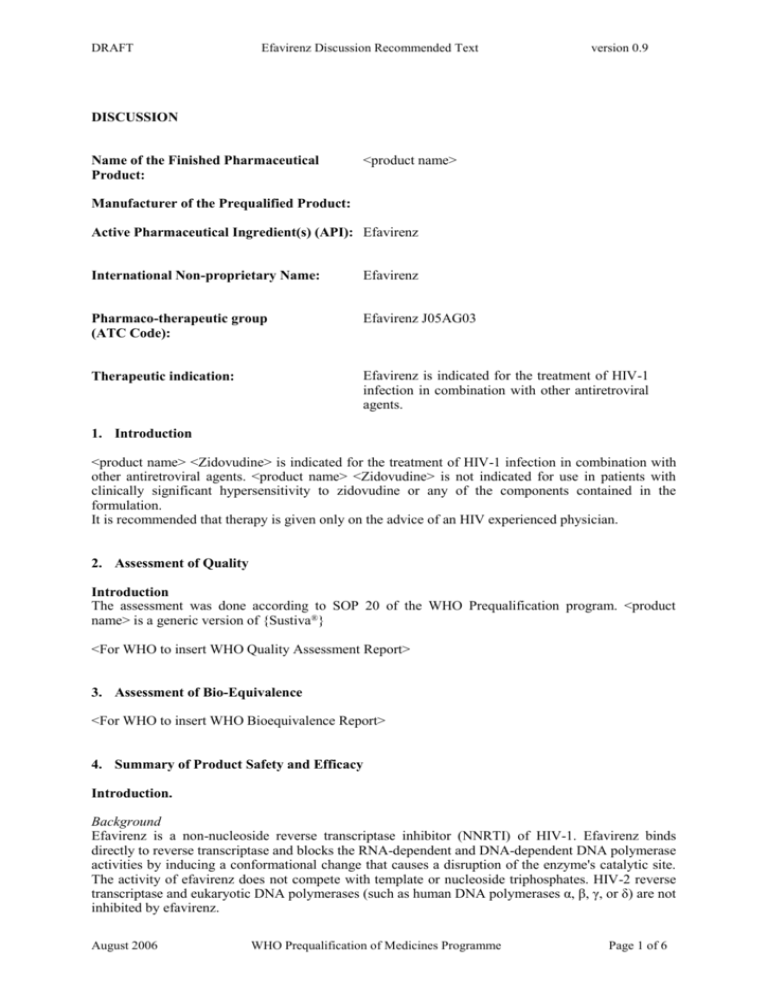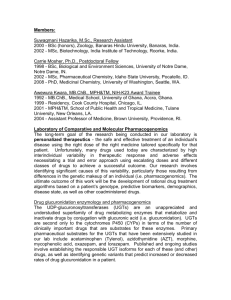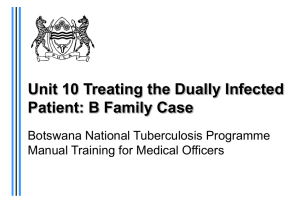efavirenz
advertisement

DRAFT
Efavirenz Discussion Recommended Text
version 0.9
DISCUSSION
Name of the Finished Pharmaceutical
Product:
<product name>
Manufacturer of the Prequalified Product:
Active Pharmaceutical Ingredient(s) (API): Efavirenz
International Non-proprietary Name:
Efavirenz
Pharmaco-therapeutic group
(ATC Code):
Efavirenz J05AG03
Therapeutic indication:
Efavirenz is indicated for the treatment of HIV-1
infection in combination with other antiretroviral
agents.
1. Introduction
<product name> <Zidovudine> is indicated for the treatment of HIV-1 infection in combination with
other antiretroviral agents. <product name> <Zidovudine> is not indicated for use in patients with
clinically significant hypersensitivity to zidovudine or any of the components contained in the
formulation.
It is recommended that therapy is given only on the advice of an HIV experienced physician.
2. Assessment of Quality
Introduction
The assessment was done according to SOP 20 of the WHO Prequalification program. <product
name> is a generic version of {Sustiva®}
<For WHO to insert WHO Quality Assessment Report>
3. Assessment of Bio-Equivalence
<For WHO to insert WHO Bioequivalence Report>
4. Summary of Product Safety and Efficacy
Introduction.
Background
Efavirenz is a non-nucleoside reverse transcriptase inhibitor (NNRTI) of HIV-1. Efavirenz binds
directly to reverse transcriptase and blocks the RNA-dependent and DNA-dependent DNA polymerase
activities by inducing a conformational change that causes a disruption of the enzyme's catalytic site.
The activity of efavirenz does not compete with template or nucleoside triphosphates. HIV-2 reverse
transcriptase and eukaryotic DNA polymerases (such as human DNA polymerases α, β, γ, or δ) are not
inhibited by efavirenz.
August 2006
WHO Prequalification of Medicines Programme
Page 1 of 6
DRAFT
Efavirenz Discussion Recommended Text
version 0.9
Product Design.
The development strategy for <product name> was …. {product specific}
Unique Product Characteristics
{The product is presented in the form of size 2 hard gelatine capsules (white body, blue cap, both
imprinted S40) containing white to off-white coloured powder.}
< product specific>
Approved Indication
<product name> <Efavirenz> is indicated for the treatment of HIV-1 infection in combination with
other antiretroviral agents.
Clinical Pharmacology
Pharmacodynamics
Efavirenz is a non-nucleoside reverse transcriptase inhibitor (NNRTI) of HIV-1. Efavirenz binds
directly to reverse transcriptase and blocks the RNA-dependent and DNA-dependent DNA polymerase
activities by inducing a conformational change that causes a disruption of the enzyme's catalytic site.
The activity of efavirenz does not compete with template or nucleoside triphosphates. HIV-2 reverse
transcriptase and eukaryotic DNA polymerases (such as human DNA polymerases α, β, γ, or δ) are not
inhibited by efavirenz.
Pharmacokinetics
Absorption and Bioavailability
Bioavailability is 40% to 45% without food. Fat-containing meals increase absorption
significantly.
Peak efavirenz plasma concentrations of 1.6 - 9.1 µM were attained by 5 hours following single oral
doses of 100 mg to 1,600 mg administered to uninfected volunteers. Dose related increases in Cmax
and AUC were seen for doses up to 1,600 mg; the increases were less than proportional suggesting
diminished absorption at higher doses. Time to peak plasma concentrations (3 - 5 hours) did not
change following multiple dosing and steady-state plasma concentrations were reached in 6 - 7 days.
In HIV infected patients at steady state, mean Cmax, mean Cmin, and mean AUC were linear with 200
mg, 400 mg, and 600 mg daily doses. In 35 patients receiving efavirenz 600 mg once daily, steady
(57%), and AUC was 184 ± 73 µM·h (40%).
Distribution
Efavirenz is highly bound (approximately 99.5 - 99.75%) to human plasma proteins, predominantly
albumin. In HIV-1 infected patients (n = 9) who received efavirenz 200 to 600 mg once daily for at
least one month, cerebrospinal fluid concentrations ranged from 0.26 to 1.19% (mean 0.69%) of the
corresponding plasma concentration. This proportion is approximately 3-fold higher than the nonprotein-bound (free) fraction of efavirenz in plasma.
Metabolism / Elimination
Efavirenz is principally metabolised by the cytochrome P450 system to hydroxylated metabolites with
subsequent glucuronidation of these hydroxylated metabolites. These metabolites are essentially
inactive against HIV-1. The in vitro studies suggest that CYP3A4 and CYP2B6 are the major
isozymes responsible for efavirenz metabolism and that it inhibited P450 isozymes 2C9, 2C19, and
3A4. In in vitro studies efavirenz did not inhibit CYP2E1 and inhibited CYP2D6 and CYP1A2 only at
concentrations well above those achieved clinically. Efavirenz has been shown to induce P450
enzymes, resulting in the induction of its own metabolism. In uninfected volunteers, multiple doses of
200 - 400 mg per day for 10 days resulted in a lower than predicted extent of accumulation (22 - 42%
lower) and a shorter terminal half-life of 40 - 55 hours (single dose half-life 52 - 76 hours). Efavirenz
has a relatively long terminal half-life of 52 to 76 hours after single doses and 40 - 55 hours after
August 2006
WHO Prequalification of Medicines Programme
Page 2 of 6
DRAFT
Efavirenz Discussion Recommended Text
version 0.9
multiple doses. Approximately 14 - 34% of a radiolabelled dose of efavirenz was recovered in the
urine and less than 1% of the dose was excreted in urine as unchanged efavirenz.
Drug Interactions, related side effects and contra indications.
Efavirenz is contraindicated in patients with clinically significant hypersensitivity to
efavirenz or to any of the components contained in the formulation.
Efavirenz is an inducer of the hepatic enzyme CYP3A4 and an inhibitor of some CYP isozymes
including CYP4A; therefore, it is possible that co-administration of efavirenz with medicinal products
(for example astemizole, terfenadine, cisapride, midazolam, triazolam, ergot derivatives and St. John’s
wort) or food (for example, grapefruit juice) which affect CYP3A4 activity may result in an alteration
in the plasma concentration of either agent.
Efavirenz decreases plasma concentrations of methadone (1). Methadone-maintained patients
beginning efavirenz therapy should be assessed for evidence of withdrawal and methadone dose
should be adjusted accordingly.
Rifampicin may significantly decrease levels of efavirenz (2). Rifampin levels are unaffected.
Efavirenz decreases serum levels of atorvastatin, pravastatin and simvastatin (3).
Efavirenz decreases serum levels of clarithromycin and increases the risk of rash significantly.
Efavirenz increases levels of ethinyl estradiol. Barrier contraception should always be used in
combination with other contraceptive methods.
Efavirenz significantly decreases levels of amprenavir, atazanavir, indinavir, lopinavir, and saquinavir
but increases levels of nelfinavir and ritonavir. Therefore, if efavirenz is given with either of these
drugs, dosage adjustments of either may be necessary or alternatively ritonavir boosting may be
necessary. Efavirenz does not alter the levels of fos-amprenavir or tipranavir. Ritonavir significantly
increases levels of efavirenz.
Clinical Efficacy.
Efavirenz has been investigated in several randomized, prospective clinical trials combined with other
antiretroviral drugs (4-15). These studies have demonstrated significant decreases in plasma HIV RNA
and increases in CD4 cell counts when used in combination with other nucleoside analogue(s) and/or a
PI. In recent studies by intention-to-treat analysis > 70% of subjects have achieved plasma HIV RNA <
50 copies/mL after 48 weeks of combination treatment that included efavirenz with other antiretroviral
drugs (5, 15).
HIV-1 resistance to efavirenz involves the development of mutations in the reverse transcriptase gene
at positions 100, 103, 106, 108, 181, 188 and 190 (www.iasusa.org). The K103N or Y188L mutation
alone prevents the clinical utility of efavirenz. The V106M mutation is more common in HIV-1
subtype C than subtype B.
Rapid emergence of resistance to NNRTIs, including efavirenz, is likely to occur in case of virological
failure.
Patients who are infected with known efavirenz-resistant HIV or patients who have previously
experienced virological failure on a efavirenz- or nevirapine-containing regimen may not respond
sufficiently to further treatment with a combination regimen containing efavirenz or nevirapine.
Clinical studies in special populations
Liver Disease
No dose adjustment is necessary for mild to moderate liver impairment but discontinuation
may be necessary for severe liver impairment.
August 2006
WHO Prequalification of Medicines Programme
Page 3 of 6
DRAFT
Efavirenz Discussion Recommended Text
version 0.9
Renal Impairment
No dose modification (16, 17).
Clinical Safety
The following adverse events have been reported in controlled clinical trials and case series during
treatment of HIV infection with efavirenz.
The adverse events considered at least possibly related to the treatment are listed below by body
system, organ class and absolute frequency. Frequencies are defined as very common (>1/10),
common (>1/100, <1/10), uncommon (>1/1000, <1/100), rare (>1/10,000, <1/1000), very rare
(<1/10,000).
Metabolic and nutrition disorders:
Very common: Increases in fasting triglycerides, total cholesterol, high- and low-density lipoprotein
cholesterol (18, 19).
Common: Gynaecomastia (20).
Nervous system disorders
Very common: confusion, dizziness, insomnia, somnolence, impaired concentration and abnormal
dreaming (4, 21).
Common: Anxiety and depression (8) .
Uncommon: Psychosis (increased likelihood in those with history of psychiatric disease).
Hepatobiliary disorders
Common: Elevation of liver enzymes (22, 23).
Skin and subcutaneous tissue disorders
Very common: Rash (4, 8, 24).
Some patients accidentally taking 600 mg twice daily have reported increased nervous system
symptoms. One patient experienced involuntary muscle contractions. Treatment of overdose with
efavirenz should consist of general supportive measures, including monitoring of vital signs and
observation of the patient’s clinical status. Administration of activated charcoal may be used to aid
removal of unabsorbed efavirenz. There is no specific antidote for overdose with efavirenz. Since
efavirenz is highly protein bound, dialysis is unlikely to remove significant quantities of it from blood.
5. Overall Conclusion and benefit risk assessment
Quality
The quality of this product is considered to be acceptable when used in accordance with the conditions
defined in the SPC. Physicochemical and biological aspects relevant to the uniform clinical
performance of the product have been investigated and are controlled in a satisfactory way.
Bioequivalence
<product name> has shown to be bioequivalent to comparator product <Sustiva®>.
Efficacy and Safety
Regarding clinical efficacy and safety, efavirenz is considered effective and safe to use when the
guidance and restrictions presented in the Summary of Product Characteristics is taken into
consideration.
Benefit Risk Assessment
Based on the WHO assessment of data on quality, bioequivalence, safety and efficacy the team of
assessors considered by consensus that the benefit risk profile of <product name> was acceptable for
the following indication: HIV infection in combination with other antiretroviral agents and has
advised to include <product name> in the list of pre-qualified medicinal products and manufacturers.
August 2006
WHO Prequalification of Medicines Programme
Page 4 of 6
DRAFT
August 2006
Efavirenz Discussion Recommended Text
WHO Prequalification of Medicines Programme
version 0.9
Page 5 of 6
DRAFT
Efavirenz Discussion Recommended Text
version 0.9
Reference List
1.
2.
3.
4.
5.
6.
7.
8.
9.
10.
11.
12.
13.
14.
15.
16.
17.
18.
19.
20.
21.
22.
S. M. Clarke et al., Br. J. Clin. Pharmacol. 51, 213 (2001).
L. F. Lopez-Cortes et al., Clin. Pharmacokinet. 41, 681 (2002).
J. G. Gerber et al., J. Acquir. Immune. Defic. Syndr. 39, 307 (2005).
S. Staszewski et al., N. Engl. J. Med. 341, 1865 (1999).
G. K. Robbins et al., N. Engl. J. Med. 349, 2293 (2003).
R. W. Shafer et al., N. Engl. J. Med. 349, 2304 (2003).
K. Squires et al., J. Acquir. Immune. Defic. Syndr. 36, 1011 (2004).
F. van Leth et al., Lancet 363, 1253 (2004).
R. M. Gulick et al., N. Engl. J. Med. 350, 1850 (2004).
M. S. Saag et al., JAMA 292, 180 (2004).
J. E. Gallant et al., JAMA 292, 191 (2004).
E. DeJesus et al., Clin. Infect. Dis. 39, 1038 (2004).
E. DeJesus et al., Clin. Infect. Dis. 39, 411 (2004).
G. J. Moyle et al., J. Acquir. Immune. Defic. Syndr. 38, 417 (2005).
J. E. Gallant et al., N. Engl. J. Med. 354, 251 (2006).
H. Izzedine, G. Aymard, V. Launay-Vacher, A. Hamani, G. Deray, AIDS 14, 618 (2000).
M. John Gill, N. J. Ostrop, W. D. Fiske, J. M. Brennan, AIDS 14, 1062 (2000).
M. Nunez et al., HIV. Clin. Trials 3, 186 (2002).
L. F. van et al., PLoS. Med. 1, e19 (2004).
J. A. Mira et al., Antivir. Ther. 9, 511 (2004).
D. B. Clifford et al., Ann. Intern. Med. 143, 714 (2005).
M. S. Sulkowski, D. L. Thomas, S. H. Mehta, R. E. Chaisson, R. D. Moore, Hepatology 35,
182 (2002).
23. L. Martin-Carbonero, M. Nunez, J. Gonzalez-Lahoz, V. Soriano, HIV. Clin. Trials 4, 115
(2003).
24. J. Ananworanich et al., AIDS 19, 185 (2005).
August 2006
WHO Prequalification of Medicines Programme
Page 6 of 6











